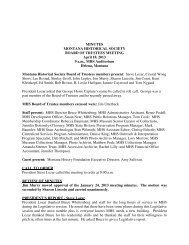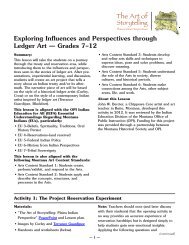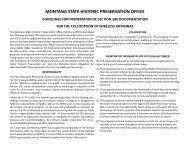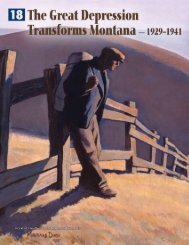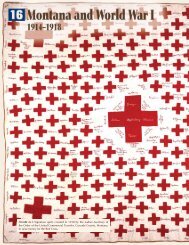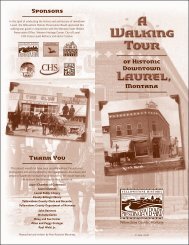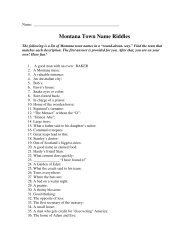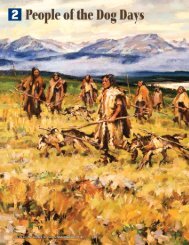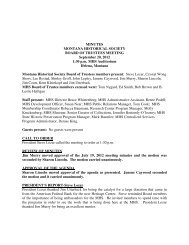Chapter 11 - Montana Historical Society
Chapter 11 - Montana Historical Society
Chapter 11 - Montana Historical Society
You also want an ePaper? Increase the reach of your titles
YUMPU automatically turns print PDFs into web optimized ePapers that Google loves.
“I Am Given Little Food”<br />
“We old Indians never knew of any way of obtaining<br />
food except by hunting. The government promised to<br />
feed us if we would live on the reservations. But I am<br />
given very little food. Each month our Indian policeman<br />
brings me one quart of green coffee, one quart<br />
of sugar, a few pounds of flour and a small quantity<br />
of baking powder. I am told that I might get more if<br />
I should go each month and ask the agent for it. But<br />
my home is more than 20 miles over a mountain . . .<br />
It should not be expected that a 92-year-old woman<br />
get her food by personally going to the agency every<br />
month on a certain day and during certain hours of<br />
the day . . . It would be hard enough in summer. It is<br />
impossible in winter.”<br />
—IRON TEETH, A NORTHERN CHEYENNE WOMAN<br />
FIGURE <strong>11</strong>.6: Chief Mountain has been<br />
a sacred area to Blackfeet Indians<br />
for hundreds of years. It is part of the<br />
land the tribe sold in 1895. “Chief<br />
Mountain is my head,” said Blackfeet<br />
leader White Calf. “Now my head is<br />
cut off.” American painter John Fery<br />
(1859 –1934) painted this picture of<br />
Chief Mountain around 1915.<br />
2 1 2 P A R T 2 : A C E N T U R Y O F T R A N S F O R M A T I O N<br />
Browning—so old it was contaminated with<br />
maggots.<br />
Approximately one-quarter of the Blackfeet<br />
tribe—600 people—died from starvation. The<br />
Assiniboine lost approximately 300 people.<br />
Many Gros Ventre and Sioux also died from<br />
hunger and exposure. Tribal people call this<br />
period “Starvation Winter.”<br />
After Starvation Winter, the tribes sold<br />
the only resource they had left—land. The<br />
Sweetgrass Hills Agreement of 1888 reduced<br />
the large northern Indian reserve to<br />
three smaller reservations: the Blackfeet, Fort<br />
Belknap, and Fort Peck Reservations.<br />
In 1895 the Blackfeet sold another strip<br />
of land that prospectors hoped would contain<br />
gold. When no gold was found there,<br />
most of this land became Glacier National<br />
Park. The next year the government pressured the Assiniboine and<br />
Gros Ventre to sell a 28-square-mile chunk of the sacred Little Rocky<br />
Mountains. There miners developed a large gold mine.<br />
Life on the Reservations<br />
By 1888 nine Indian tribes—the Blackfeet, Crow, Assiniboine, Gros Ventre,<br />
Sioux, Salish, Kootenai, Pend d’Oreille, and Northern Cheyenne—were<br />
living on six <strong>Montana</strong> reservations. (Rocky Boy’s Reservation—home<br />
to members of the Chippewa and Cree tribes—was not established until<br />
1916. See <strong>Chapter</strong> 15.)<br />
Government policies on<br />
the reservations refl ected<br />
what many non-Indians<br />
thought at the time: that<br />
the best way for Indians to<br />
adjust to a rapidly changing<br />
world was to give up<br />
their tribal traditions and<br />
live like Euro-Americans<br />
(Americans with European<br />
influence or ancestry).<br />
Assimilation (when one<br />
culture is absorbed into another,<br />
majority culture) was<br />
the goal of the reservations.<br />
So while American Indian<br />
tribes struggled to main-



